From Berlin To Japingka – Ampilatwatja Artists Bring Their Joy
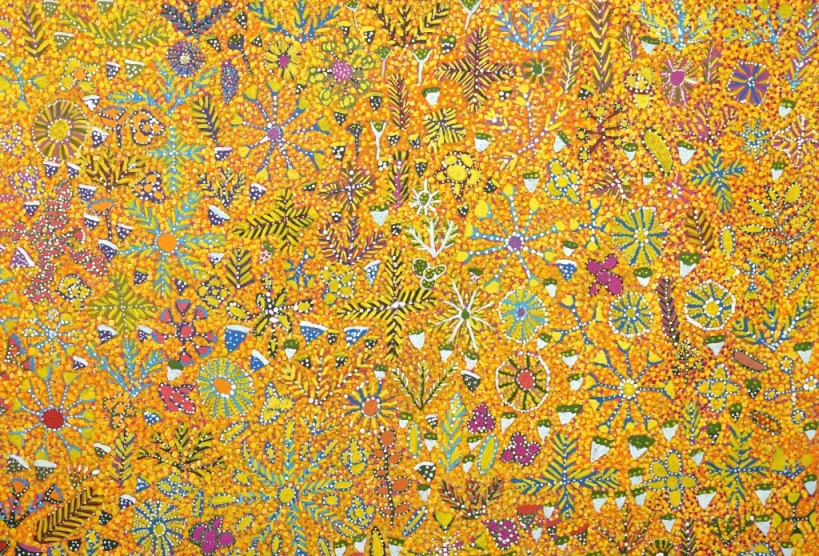
Caroline Hunter is Community Art Manager for the Artists of Ampilatwatja Aboriginal Corporation. In this interview, she talks about the art, the work of the art centre and the success of their recent Berlin exhibition.
How do you pronounce the community name?
It's pronounced um-blood-a-witch.
Where Is Ampilatwatja?
How would you describe the community of Ampilatwatja?
It's small and it's remote. We are located 370 kilometres northeast of Alice Springs. The community is inaccessible if there's any significant rain or there are extended periods of rain. The community services probably about 350 people. Many are quite transient because people move to and from a lot of outstations. We have no police station, so it gives you a bit of an idea how small it is. I'd say there are probably 26 houses. The main source of income is the art centre. There's a clinic, a school, a council office and a shop.
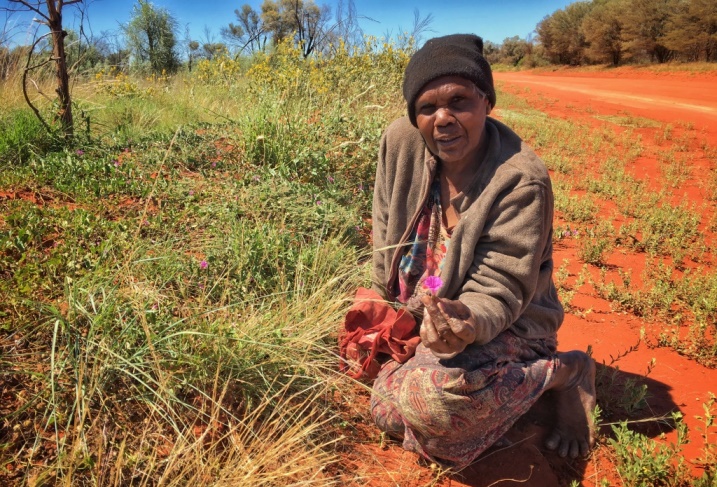
When did you first go there?
I arrived in 2010. The art centre had been closed for a while. There wasn't a manager's house, so the person taking on the job was either staying with people or living in a caravan. You can't run a sustainable business living like that because this area experiences extreme conditions. It's really hot in summer, and it's freezing in winter.
How did you find those days when you arrived?
It was really difficult at first because I lived in the art centre before it was renovated. I went in as a consultant to oversee the building of the new manager accommodation and the renovation of the art centre. I was engaged to get the business back on its feet. It was rough back then. There was an old shed that had been given to the artists. The walls were incomplete so cats and dogs would go in there. We'd get a bucket of water from the neighbours and clean it out. We'd take a swag and that's where we'd sleep. Now there's a lovely manager's home and that's where I live. The art centre is renovated, and a new art studio has been added. The business is starting to look ahead.
What seemed to be the most important role for you when you arrived?
It was important to get the manager's house built so then we could progress to employing a manager. To entice professional people you have to have the lure of a good business model and a secure, clean house. Arts managers also have to believe that they will be working with talented artists. We have all of that in place.
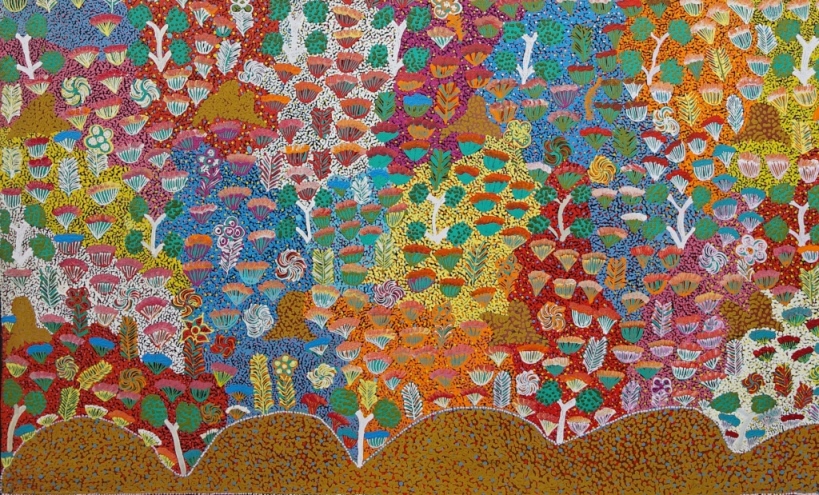
Traditional Values
What would you describe is the values of the community?
This is a very traditional community. They're still very steeped in culture, and that comes first. They are one of the very few communities that still have a lot of traditional ceremonies.
What are the greatest challenges for the community?
Poverty is the big one. Job opportunities, education, there's a lot of challenges there. There are also significant health issues for people in a remote community like this one.
A Distinctive Style of Art
What is distinctive about their art?
Their work is quite different. They use beautiful bright colours. They paint landscapes with very fine dot work. I think that's what people are drawn to. Whether they know the landscape or not, they'll always identify the paintings as being pretty pictures. People who have actually been there and travelled through those landscapes, they can recognise those places. The images are quite specific to the country.
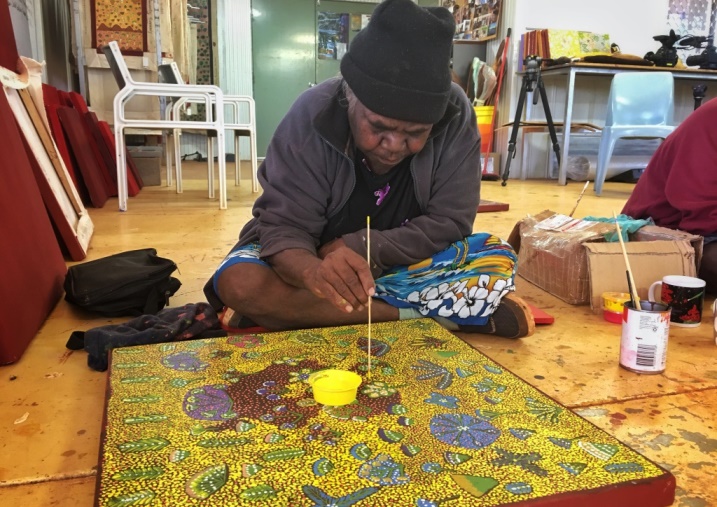
Can you talk a little about how the tradition, their painting tradition evolved?
The community decided that they weren't going to be painting their Creation Stories. Instead, they chose to paint the landscape where those stories belong.
The Artists
How many artists work through the art centre?
There are about 185 artists on our books. There would be a regular flow of about 40 painters.
Are there separate roles for men and women?
The men tend to make all the artefacts. A few of the men will paint with their partner. There are about three couples who paint together.
Do they paint in silence or do they have music - what's the atmosphere like?
A lot of the artists prefer to paint at home. These home environments are places where there can be many pressures. At the very least there is usually a general lack of space. To produce in these beautiful works is such a credit to them.
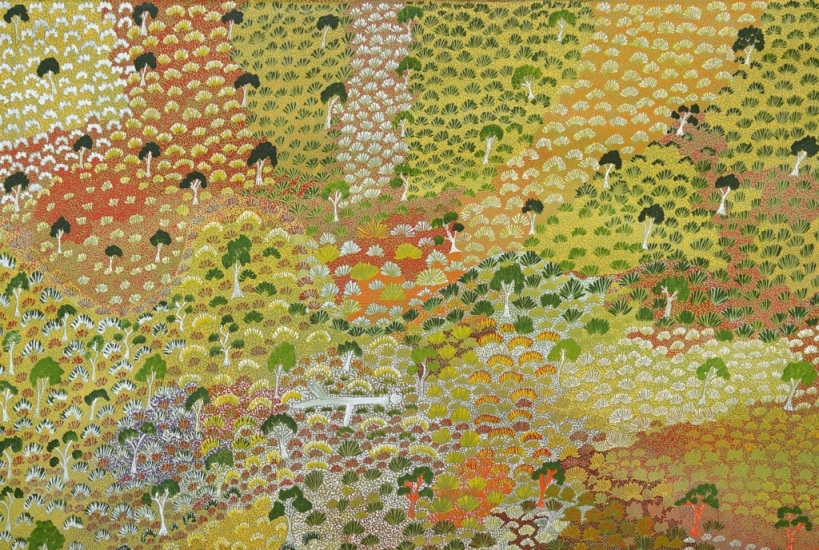
How do they feel about their art?
There is a real sense of pride. The artists bring in these beautifully executed fine works that they created in the most challenging of conditions. You won't see so much as a smudge or a mark on them.
What is the art centre like?
It's still tricky to work out of because it's really small. Many of the artists choose to paint at home, and that alleviates some of the congestion. It's a really small outfit, and we still manage to achieve really big stuff. It's because of the artists. It's because they have such a sense of pride in the work that they produce. They know that this work opens up opportunities for travel, it doesn't necessarily need to be travel that takes them very far. They also see Facebook and the website. They see the type of places where their work goes. They have an understanding of the big picture.
How The Art Centre Contributes
What does the art practice contribute to the community?
The art centre, the physical place itself, provides an amazing place for the women to come to. It's a nice environment to visit and have a cup of tea. If they want, they've got a nice studio to paint in.
Sales of the artwork subsidises the whole community because it's the major source of income for artists. It is an important place for the health of the artists. They can produce work, earn an income, feel like there's value in what they do. The sale of the work is always something that validates that. I think people who struggle with health issues whether they are physical or mental are helped with this boost to their confidence and a sense of purpose.

The Silks
Tell us about the range of silk scarves with the artists' designs.
We have some artists whose work is particularly detailed. They don't produce a lot of paintings because their work takes a very long time to finish. By reproducing these designs onto an item of merchandise like a silk product, they can have a product in the marketplace that is affordable. It also means that there's a consistent return to the artist through sales.
We learned a lot from our first run of silk scarves some years ago. We learnt what sold and what people liked. The silk scarves are quite an elegant product. A designer came to us with the idea, and we went with it.
How does the art centre plan it's exhibition schedule each year?
Some years we can be booked out, and other years it can be organic. We might know what's happening two years in advance because a lot of people like to book that far in advance. It might take a year to get a high-end show organised. It's a bit of both. The galleries tell us when there's a space available and when they want us. We try not to do too much in a year because there's only so much we can supply. Often our sales outstrip that supply. It's quite a challenge to manage an exhibition schedule and get the balance right. These days people sometimes like to have shows every second year. We've got many different works with different marketplaces, and right now it's working well for us.
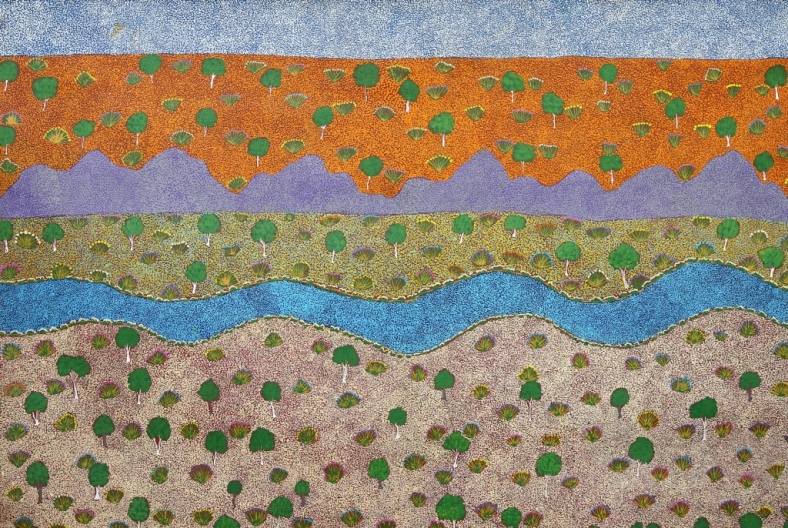
Exhibition At Australian Embassy in Berlin
Tell us about exhibiting in Europe, how were the venues and what was the response?
The response there was fantastic. There was a show in the Australian embassy in Berlin. They said that it was their best show yet.
We sold just about every painting. The exhibition wasn't open to the public; it was an invitation-only event. It was a real success for us. It's easy though when you've got gallery representation because they're the ones that do all the hard work.
What do you enjoy most about the job of community art manager?
It's the people. They're a great community. The artists are just the loveliest people. I enjoy seeing the pride in the artwork that they bring in. They love what they create. It makes it so much easier when the paintings are easy to sell or you've got a list of people waiting to purchase artwork.
The other thing I enjoy about the job is that things aren't ever standard. There are always great opportunities. We might be working with a designer or an architect. There are new projects and big projects to arrange. There are opportunities to travel with the work internationally. The other thing I enjoy is that the artists are always enthusiastic. If there's a workshop or an opportunity to go to Alice Springs for something, I never have to worry about whether anybody will turn up. They're a great crew to work with because I can count on them to support whatever we are working towards.

Can you tell me about some of the things you've learned over time from working in that position?
You have to listen. That's where you'll get the answers you need. I've also come to appreciate that just because somebody's English may not be particularly good or very limited, they're still full of respect for themselves. They have very strong opinions. They enjoy having a say in the decisions that relate to the business.
I don't think they want us to turn this into some multi-million dollar art centre. That's not what they want. They like the fact that it's moving along at a steady pace, but not too fast that they can't keep up. The artists also want their kids involved, and they are getting their kids involved. I think that's paramount to the success of the business.
How does the future look for the artists and the community?
I think the community has got a really strong art centre. They've positioned themselves well in the marketplace. This community business should be around for a long time. Younger people are taking an interest in art. People are so much more computer savvy, and they're on Facebook. They're following their grandmothers, following their mothers, and now they're realising, hey I can paint as well. They're coming on board. Some of the young men are coming down to paint. I believe there will be some exciting talent coming through over the next couple of years.
You know these are young people who have had no training. What they can produce is just fantastic. All they know is what they've observed in their homes.

More Investment Needed
What do you think is the single thing that would most benefit the arts group?
I think more funding in the community would mean we'd be able to achieve more regular skills sharing workshops for the arts group.
We need a proper building rather than operating out of a renovated shed. We're operating out of a really old and antiquated building at the moment. We need something designed to facilitate arts work across a bigger geographical area. Not just Ampilawatja, all the homelands and down to Utopia. We need a couple of million dollars to be invested in this community to enable the continued development of this very successful art business.
Sometimes you find canvases left at your door. Why is that?
Artists bring work down to the art centre, but they don't always come in. They'll leave the canvas outside, and they'll sit around having a chat. The canvases could be left out there for ages, and then somebody will mention it to us. We'll go and get the canvas and bring it in. We all get excited to see the new beautiful work. It is a lovely time.
The artists don't come inside because they're embarrassed that there might be a fuss. They don't want a song and dance made about their work. They love to paint, and then they leave it for the art centre to arrange the rest.
This community has been identified as one of the poorest communities in Australia. Even so, their work is of such a high standard. It comes out of love and joy. There's certainly a serious sense of pride among the artists. This is their art, their business and their art centre.
Read: Australian Aboriginal Art Centre Management
Explore: Aboriginal Art For The USA
